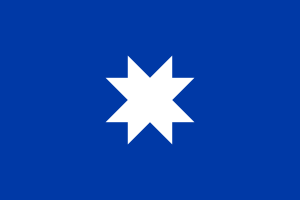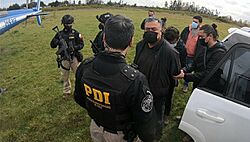Coordinadora Arauco-Malleco facts for kids
Quick facts for kids Coordinadora Arauco Malleco |
|
|---|---|
| Participant in the Mapuche conflict | |

Emblem used by the Organos de Resistencia Territorial (military arm) in sabotage actions awarded by the CAM. The image represents a guemil (symbol of Mapuche iconography) with a Mapuche clava inside it.
|
|
| Active | 1997–present |
| Ideology |
|
| Leaders | Héctor Llaitul |
| Area of operations | La Araucania Region and Bio Bio Region |
| Allies | |
| Opponents |
|
The Coordinadora Arauco-Malleco (CAM) is a group that uses strong actions to try and create an independent Mapuche state. They call this land "Wallmapu". The Mapuche are an Indigenous people from parts of Chile and Argentina.
CAM was started in 1998 in Tranaquepe, Chile. It formed because the Mapuche conflict became more active. This conflict was fueled by the poverty and unfair treatment the Mapuche people had faced for over a hundred years. CAM believes its actions are a way to defend themselves in their fight for self-rule. Their ideas mix Mapuche traditions with Western political ideas and what they have learned from experience.
CAM has taken over land in areas like Tirúa, Contulmo, Cañete, and Temucuicui. They are known for setting fire to logging trucks and farms in areas they claim as their own. While sometimes these actions have affected regular people, their main goal is to damage property belonging to those they believe have taken their land. Most of their actions are done secretly. However, sometimes they lead to clashes with the special police forces of Carabineros de Chile. CAM has also supported smaller Mapuche communities in taking direct action against logging companies and landowners. They do this by offering organized support to try and influence political decisions.
On May 31, 2022, the Chilean government's parliament voted on a request to declare CAM and other groups as "illegal terrorist organizations." The vote was 66 in favor, 43 against, and 13 abstentions.
Contents
History
How CAM Started
The building of the Ralco Hydroelectric Plant was a major turning point in how the Chilean government and Mapuche people got along. This power plant moved ancient Mapuche burial grounds. This event helped lead to the formation of CAM in 1997. It happened after three trucks belonging to a company called Forestal Arauco were burned. This marked the start of increased conflict in the Southern Macrozone of Chile, also known as the Araucanía conflict. It also changed how the Mapuche movement seeking self-rule developed. Since then, the conflict has grown and spread to nearby regions like Biobío and Los Lagos.
In 1996, some Mapuche communities formed the Lafkenche Territorial Coordinator. In 1998, a conflict arose in Traiguén. After this, a meeting of communities and a Guillatún (a Mapuche ceremony) took place. Communities from Arauco and Lumaco, the Mapuche Coordinator of Santiago, and the Mapuche Organization Meli Wixan Mapu from Santiago attended this meeting. Leaders from Collipulli also joined. During this meeting, they decided to have another meeting only for Mapuche communities involved in conflicts. At this second meeting, they decided to form the "Mapuche Coordinator of Communities in Conflict Arauco Malleco," which became CAM.
The group's first action happened on December 1, 1997. In the area of Lumaco, community members, who later became known as CAM members, stopped three trucks from Forestal Arauco. This action created a new way of thinking for Mapuche activists. It led to more clashes with security forces.
According to historian Jorge Pinto Rodríguez, CAM has led the most active Mapuche actions up to 2017. He said they use the idea of the "weichafe," which means warrior in Mapudungun. Pinto explained that CAM started because the government did not respond to requests to lessen the effects of logging, mining, and water power projects in La Araucanía, or Wallmapu (which means "ancestral territory" in Mapudungun). He added, "They are against a government they call unfair and focused on money. They emerged at the end of the 1990s, a time of Indigenous protests across the continent, and they took up the cause in Chile."
Actions
2009 Incidents
On August 12, 2009, Chilean officials said that about 80 Mapuche people entered and occupied a large farm called "San Sebastián." This farm is located between Collipulli and Angol. The occupation happened because their request to buy the farm from the authorities had not been answered. Sergio González Jarpa, the farm owner, asked the court in Angol to remove the people occupying his land. Carabineros gathered special forces from Araucanía Region and brought in a GOPE unit from Santiago. The removal began around 2:00 PM. During this event, a young Mapuche man named Jaime Mendoza Collio was killed, and one carabinero was injured in the leg. The leader of the Mapuche organization Consejo de Todas las Tierras, Aucán Huilcamán, strongly criticized the police actions. He called the killing an unlawful killing. Later, the Chilean forensic service stated that Jaime Mendoza Collio had been shot from behind. Investigations by the Policía de Investigaciones showed that Jaime Mendoza Collío did not have gunshot residue on his hands, as Carabineros had suggested.
The events of 2009 brought the CAM issue back to the government's attention. Some political parties claimed that previous governments had not done enough to arrest those responsible for the actions and protect private property. On August 19, Chilean President Michelle Bachelet spoke about an incident between a minister and an opposition politician. The politician threw a copy of a document related to the release of former CAM leader Víctor Ancalaf at the minister. Víctor Ancalaf had served 5 years of a 10-year prison sentence for serious crimes, which Ancalaf strongly denies.
Deaths of Werner Luchsinger and Vivianne Mackay
The most serious case linked to CAM is the deaths of Werner Luchsinger and Vivianne Mackay. They were a wealthy farming couple who died in a fire at their country house in Vilcún in 2013. That night, the police found machi Celestino Córdova injured by a bullet less than a mile from the Luchsinger's farm. He was later found responsible and sentenced for the deaths. He is still serving his sentence and is the only person officially charged for the deaths of the Luchsinger and Mackay. CAM claims he is innocent and was used as a scapegoat. They consider him a political prisoner.
In September 2017, the prosecutor of La Araucanía, Roberto Garrido, confirmed a connection between members of the Weichán Auka Mapu and the Luchsinger-Mackay case. This was based on ongoing investigations showing that at least 25 people were involved in the attack. The prosecutor confirmed that investigations were still happening.
International Connections
Recent information, such as CAM leaders being invited to Caracas and investigations by Colombian authorities, has shown connections between CAM, the government of president Nicolás Maduro in Venezuela, and the FARC group.
See also
 In Spanish: Coordinadora Arauco-Malleco para niños
In Spanish: Coordinadora Arauco-Malleco para niños
- Mapuche conflict
- Weichán Auka Mapu
- Resistencia Ancestral Mapuche
- Wallmapuwen
- Council of All Lands
- Association for Peace and Reconciliation in Araucanía



